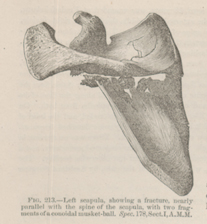Title: F——, W.
Source text: Surgeon General Joseph K. Barnes, United States Army, The Medical and Surgical History of the War of the Rebellion. (1861–65.), Part 1, Volume 2 (Washington, D.C.: Government Printing Office, 1870), 476.
Civil War Washington ID: med.d1e19215
TEI/XML: med.d1e19215.xml
CASE.—Private W. F——, Co. F, 18th Massachusetts Volunteers, aged 30 years, was wounded at Bull Run, August 30, 1862, and was admitted to hospital at Alexandria, on the following day. There was a wound of the left arm, about four inches below the acromion process , to which cold water was applied. On the 3d, and again on the 5th of September, fragments of the ball, with a few pieces of comminuted bone, were removed through an incision on the outer edge of the scapula, affording the patient considerable relief. A profuse discharge from the wound soon followed, and on the 19th, symptoms of purulent infection set in. An active treatment by stimulants, quinia, iron, and ammonia, was instituted, but unavailingly. Death resulted on September 25th. The necropsy showed a fracture of the head and dorsum of the scapula, extending below and parallel to its spine. A large collection of extravasated blood was found beneath the scapula and between the muscles of the shoulder, which were disorganized, and of a greenish hue. There was extensive serous effusion in the left pleural cavity, and numerous metastatic foci in both lungs. The fractured scapula, with two fragments of ball attached, and having upon its venter a thin layer of friable, yellowish exudation, was contributed to the Army Medical Museum by Acting Assistant Surgeon W. H. Butler, and is figured in the adjoining wood-cut (FIG. 213).


